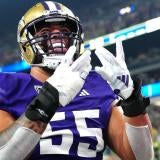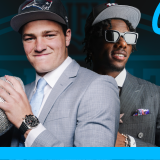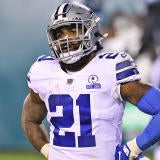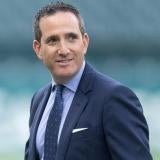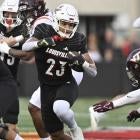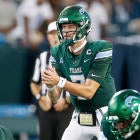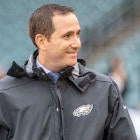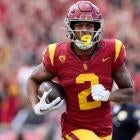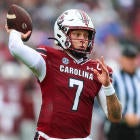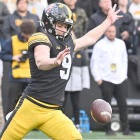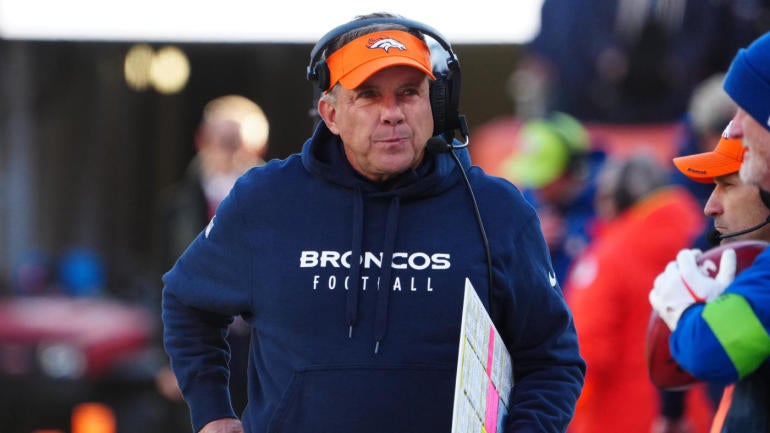
We've examined the cost of the Giants and Vikings trading up to nab a quarterback in the top-five picks, and now our attention turns to the Broncos. Fortunately for Denver, a trade up to No. 3 from No. 12 is less theoretical than most of the trade scenarios we've covered, as the 49ers did exactly that three years ago when they sent the 12th overall pick, their first-round pick in each of the following two drafts and a third-round pick in the next year's draft to get the No. 3 pick and ultimately draft Trey Lance. That deal was about 46 points above our baseline value for the No. 3 pick, which is what we've been calling medium value in our look across the three types of potential trade scenarios (also including competitive-market value) for each prospective trade-up team for each pick.
Considering the Broncos don't have a second-round pick this year, even the baseline value of trading up from 3 to 12 should cost an additional two future first-round picks. That would be 670.77 points of value, just over the package the Texans put together to move up from No. 12 to No. 3 last year that included one future first-round pick but also the No. 33 pick in the 2023 draft, which is just about the same value for us as a future first-rounder.
In a competitive-market scenario where multiple teams are jockeying to move up to No. 3? The Broncos are probably stuck giving up a fifth pick in addition to the three firsts and one third from the 49ers trade, likely in the second round of a future draft. It seems unlikely they'd be willing to meet that cost and figure in any competitive market to be outbid by a team like the Vikings with an additional first-round pick this year.
But what if the quarterback the Broncos want is available after the top-three picks? There hasn't been a straight pick trade up to No. 4 or No. 5 since at least 2016, which is the first year I began compiling and adjusting pick values for my trade chart that is based around the pick trades teams actually make before and during each year's draft. However, I do have values attached to both picks based on the values from other picks in the top 10, with the fifth pick 9% more valuable than the sixth pick, and the fourth pick 11% more valuable than the fifth pick (the third pick is then 14% more valuable than the fourth pick, in case you're wondering).
I've built potential trade scenarios for the Broncos in the three different types of markets we've covered (baseline, medium, competitive) for each of the fourth and fifth overall picks. It seems more likely to me that the Broncos would trade back and take a second-tier QB in the No. 20 to No. 50 range of the draft than beat out other competitors for No. 4 or 5, but you never know what could happen, even on the day of the draft, as we've seen in past years.
For more draft coverage, you can hear in-depth analysis twice a week on "With the First Pick" -- our year-round NFL Draft podcast with NFL Draft analyst Ryan Wilson and former Vikings general manager Rick Spielman. You can find "With the First Pick" wherever you get your podcasts: Apple Podcasts, Spotify, YouTube, etc. Listen below!
Trading to No. 4
Baseline value
- Broncos receive No. 4 (577.65 points)
- Cardinals receive No. 12, No. 203, 2025 first-round pick and 2025 second-round pick (579.19 points)
With no second-round pick in this year's draft, the Broncos are stuck trading their first- and second-round picks next year to get almost enough value with the No. 12 pick to get to the fourth spot, and a late Day 3 pick would be enough to push them over the line. However, that's in a scenario where they're likely the only team looking to move up for the QB who remains.
Medium value
- Broncos receive No. 4 and No. 90 (616.73 points)
- Cardinals receive No. 12, 2025 first-round pick and 2026 first-round pick (670.77 points)
If there's some market for the pick outside of Denver, then the Broncos must be prepared to give up two future first-rounders to have a chance at beating other offers, though it'd be reasonable to expect a third-round pick from this year in return. Arizona currently has three third-round picks in the 2024 draft, and trading the last of them and getting two additional first-rounders would likely be enough to accept an offer to move down. If Denver ends up sold on all four top-rated QBs, this is a deal that could come together before the draft.
Competitive-market value
- Broncos receive No. 4 (577.65 points)
- Cardinals receive No. 12, 2025 first-round pick and 2026 first-round pick (670.77 points)
If there's a big market for the fourth overall pick to the point that any team that moves up will have to beat multiple other suitors, the Broncos would probably be resigned to giving up three first-round picks and at best getting a future fourth-round pick back in the deal. It's a deal that seems unlikely to happen on Denver's side.
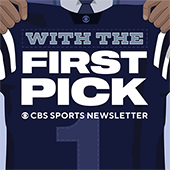
With The First Pick Newsletter
With The First Pick Newsletter
Prepare for the upcoming NFL Draft with the day’s big stories + mock drafts, big board updates and more.
Thanks for signing up!
Keep an eye on your inbox.
Sorry!
There was an error processing your subscription.
Trading to No. 5
Baseline value
- Broncos receive No. 5 (520.41 points)
- Chargers receive No. 12, No. 121, No. 203 and 2025 first-round pick (523.10 points)
It seems unlikely the Chargers would help the Broncos land a potential franchise quarterback, so don't hold your breath on these teams agreeing to a trade. However, it was just three years ago that the Cowboys allowed the Eagles to move up two spots and get DeVonta Smith ahead of the Giants. Dallas of course got the last laugh, landing Micah Parsons even after moving down.
But the Chargers are in the midst of a regime change and may value the opportunity to add assets that will bring players through the door that fit the new staff's long-term outlook better. Both coach and GM will feel safe in their jobs this year and know that they'll almost certainly get the opportunity to enjoy the fruits of an additional first-round pick in next year's draft, which is the minimum Denver should expect to spend in this type of deal.
Medium value
- Broncos receive No. 5 (520.41 points)
- Chargers receive No. 12, No. 76, No. 145 and 2025 first-round pick (567.86 points)
This deal is similar to the one above but with the non-firsts both significantly higher in this year's draft, putting this in the range of the Trey Lance deal and other medium-value scenarios we've proposed. But if a deal happens on draft night, which almost certainly would be the case as the Broncos would want to see what happens at the fourth spot if they can't make a trade there, this could be on the high end of what the pick is going to cost with the draft clock winding down, though when it's a quarterback a team has its sights set on, be ready for anything.
Competitive-market value
- Broncos receive No. 5 (520.41 points)
- Chargers receive No. 12, No. 121, 2025 first-round pick and 2025 second-round pick (593.79 points)
Teams are willing to overpay on draft night when QBs are involved; the Bears gave up about 76 points over the value of the No. 11 pick to move up for Justin Fields in that same 2021 draft that saw the Eagles and Cowboys swap picks just minutes prior. So it's worth seeing what a similar deal would look like for Denver if it wants to move up for J.J. McCarthy or any other QB that has made it to the fifth slot. This deal allows the Broncos to get their QB at the cost of sitting out the first two rounds of next year's draft, while the Chargers would be positioned to add a lot of young talent to cost-controlled deals next year as Jim Harbaugh makes a push toward unseating the Chiefs in the division.








